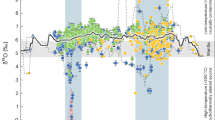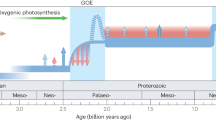Abstract
The palaeooceanography of the Arctic Ocean is less well known than any other ocean basin, due to difficulties in obtaining cores and in providing a secure chronological framework for those cores that have been raised. Most recent investigators have suggested that low sedimentation rates (0.05–0.1 cm kyr−1) have characterized the deep basins over the past 5 Myr (refs 1,2) despite the glacial–marine character of the sediment and proximity to major centres of shelf glaciation. These calculations have been primarily based on the down-core pattern in the inclination of magnetic minerals, supported by uranium-series, 14C and micropalaeontological evidence. Here we analyse amino acid diagnesis in foraminifera from two gravity cores raised from the floor of the Arctic Ocean, our results suggest that these cores span <200 kyr., conflicting with the earlier estimate of 3 Myr based on palaeomagnetic data. The chronology of other Arctic Ocean cores and previous palaeoenvironmental interpretations need re-evaluation.
This is a preview of subscription content, access via your institution
Access options
Subscribe to this journal
Receive 51 print issues and online access
$199.00 per year
only $3.90 per issue
Buy this article
- Purchase on Springer Link
- Instant access to full article PDF
Prices may be subject to local taxes which are calculated during checkout
Similar content being viewed by others
References
Herman, Y. in Marine Geology and Oceanography of the Arctic Seas (ed. Herman, Y) 285 (Springer, New York, 1974).
Clark, D. L., Whitman, R. R., Morgan, K. A. & Mackey, S. D. Geol. Soc. Am. Spec. Pap. 181, (1980).
Herman, Y. & Hopkins, D. M. Science 209, 557–562 (1980).
Hunkins, K., Be, A. W. H., Opdyke, N. D. & Mathieu, A. The Late Glacial Ages, 215–237 (Yale University Press, Connecticut, 1971).
Worsley, T. R. & Herman, Y. Science 210, 323–325 (1980).
Hare, P. E., Hoering, T. C. & King, K. Jr Biogeochemistry of Amino Acids (Wiley, New York, 1980).
Wehmiller, J. F. Quat. Sci. Rev. 1, 83–120 (1982).
Mitterer, R. M. Geology 2, 425–428 (1974).
Mitterer, R. M. Earth planet. Sci. Lett. 28, 275–282 (1975).
Wehmiller, J. F. & Belknap, D. F. Quat. Res. 9, 330–348 (1978).
McCartan, L. et al. Quat. Res. 18, 337–359 (1982).
Miller, G. H., Hollin, J. T. & Andrews, J. T. Nature 281, 539–543 (1979).
Miller, G. H., Sejrup, H. P., Mangerud, J. & Andersen, B. G. Boreas 12, 107–124 (1983).
Blunt, D. J. & Warnke, D. A. in Biogeochemistry of Amino Acida (eds Hare, P. E., Hoering, T. C. & King, K. Jr) 121–128 (Wiley, New York, 1980).
King, K. Jr & Hare, P. E. Yb Carnegie Instn Wash. 71, 691–598 (1972).
Bada, J. L. & Schroeder, R. A. Earth. planet. Sci. Lett. 15, 1–11 (1972).
King, K. Jr & Neville, C. Science 195, 1333–1335 (1977).
King, K. Jr in Biochemistry of Amino Acids (eds Hare, P. E., Hoering, T. E. & King, K.) 377–392 (Wiley, New York, 1980).
Duplessy, J. C., Chensward, L. & Vila, F. Science 188, 1208–1209 (1975).
Clement, B. M., Kent, D. V. & Opdyke, N. D. Phil. Trans. R. Soc. Lond. A306, 113–119 (1982).
Verosub, K. L. Phil. Trans R. Soc. Lond. A306, 161–168 (1982).
Holtedahl, H. J. sedim. Petrol. 29, 16–29 (1959).
Streeter, S. S., Belanger, P. E., Kellogg, T. B. & Duplessey, J. C. Quat. Res. 18, 72–90 (1982).
Sejrup, H. P., Jansen, E., Erlenkeuser, H. & Holtedahl, H. Quat. Res. 21, 74–84 (1984).
Feyling-Hanssen, R. W. Boreas 5, 77–94 (1976).
Feyling-Hanssen, R. W. Mar. Micropaleont. 5, 153–184 (1980).
Jenkins, G. & Murray, J. W. Stratigraphical Atlas of Fossil Foraminifera (Wiley, New York, 1981).
Smith, R. K. Archs Sci. Genève 23, 676–701 (1970).
Vilks, G., Wagner, F. J. E., & Pelletier, B. P. Bull geol Sur. Can. 303, (1979).
Feyling-Hanssen, R. W. Norsk geol. unders. 225, (1964)
Feyling-Hansse, E. W., Jørgensen, J. A., Knudsen, K. L. & Andersen, A-L.L. Bull. geol. Soc. Denm. 21, 67–317 (1971).
Sejrup, H. P., Holtedahl, H., Norvik, O. & Miljeteig, I. Boreas 9, 201–205 (1980).
Author information
Authors and Affiliations
Rights and permissions
About this article
Cite this article
Sejrup, H., Miller, G., Brigham-Grette, J. et al. Amino acid epimerization implies rapid sedimentation rates in Arctic Ocean cores. Nature 310, 772–775 (1984). https://doi.org/10.1038/310772a0
Received:
Accepted:
Issue Date:
DOI: https://doi.org/10.1038/310772a0
This article is cited by
-
Amino acid epimerization in planktonic foraminifera suggests slow sedimentation rates for Alpha Ridge, Arctic Ocean
Nature (1986)
-
Magnetostratigraphy and palynology demonstrate at least 4 million years of Arctic Ocean sedimentation
Nature (1985)
-
Stable isotope data and depositional environments in the late Quaternary Arctic Ocean
Nature (1985)
Comments
By submitting a comment you agree to abide by our Terms and Community Guidelines. If you find something abusive or that does not comply with our terms or guidelines please flag it as inappropriate.



